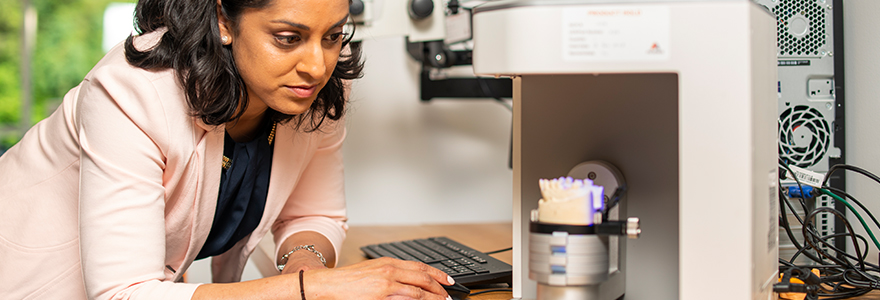The perfect fit

Harnessing the power of 3D printing, the Additive Design in Surgical Solutions Centre is helping turn research ideas into clinical reality, including a cost-effective spinal fusion cage for local orthopaedic surgeons
By Emily Leighton, MA’13
Orthopaedic surgeon Dr. Parham Rasoulinejad calls it a win-win-win – a spinal fusion cage tailored to his needs, produced using local resources, with significant cost savings for London’s hospitals.
Working with Western University’s Additive Design in Surgical Solutions (ADEISS) Centre, Rasoulinejad, Associate Professor, Surgery, is developing the 3D-printed implant as a local alternative to what is currently available on the international market.
He likens it to a custom-tailored suit – not a new product, but a perfect fit. “This project isn’t really about what we’re making, but how,” he explained. “We’re taking a pre-existing device and changing where it is produced and how it is distributed.”
The spinal fusion cage is a tiny device – it measures only about 20 to 25 millimetres in length – implanted during spinal fusion surgeries to act as a space holder. The cage is placed between affected vertebrae and designed with a lattice-like structure so that a bone graft can be placed inside, allowing bone to grow through and eventually become part of the spine.
“A lot of great ideas start at Western. ADEISS helps translate these ideas from the minds and labs of researchers into the clinical setting by providing the appropriate quality systems, technical capabilities and infrastructure.”
— Yara Hosein, PhD,
Director of Operations
Rasoulinejad estimates that he and his surgeon colleagues, Drs. Christopher Bailey, Kevin Gurr and Fawaz Siddiqi, perform about 20 to 30 of these surgeries each month. Using ADEISS’ 3D metal printing technology, he is hoping to produce a cost-effective spinal fusion cage tailored to the group’s specific needs and preferences – something that will ultimately benefit patients as well.
“The patient benefits because their surgeon is getting to use an implant that they were involved in developing and is optimized for the way they perform the surgery,” he said. “It’s rare to have a product that the surgeon likes best, that’s better for the patient and that also results in lower costs.”
The device is currently undergoing mass prototyping, for mechanical, biological and sterilization testing. The project team aims to submit it to Health Canada for approval soon after test results are obtained.
“The reason this type of project works is because ADEISS is housed within Western,” said Rasoulinejad. “It’s a unique scenario that encourages collaboration and strengthens the relationship between the University and the affiliated hospitals.”
The spinal fusion cage is just one example of the innovation taking place at ADEISS. Established in 2017, the company was developed in partnership between Western and British engineering firm Renishaw. It is located at Western’s Discovery Park and brings together research, technical and business development teams from across the city, including Schulich Medicine & Dentistry.
“A lot of great ideas start at Western,” explained Yara Hosein, PhD, Director of Operations. “ADEISS helps translate these ideas from the minds and labs of researchers into the clinical setting by providing the appropriate quality systems, technical capabilities and infrastructure.”
“The patient benefits because their surgeon is getting to use an implant that they were involved in developing and is optimized for the way they perform the surgery. It’s rare to have a product that the surgeon likes best, that’s better for the patient and that also results in lower costs.”
— Dr. Parham Rasoulinejad
Hosein works with a small, dedicated team to support this research and development, as well as entrepreneurship, including Jennifer Dawe, Director of Quality Assurance and Regulatory Affairs, Julia Hoare, Director of Finance and Administration, and David Pacifico, Engineering Technician.
In addition to routine devices like the spinal fusion cage, the company also focuses on manufacturing patient-specific devices, including cranio-facial implants to repair bone damaged from injury or cancer.
Standard implants are not a perfect fit for every patient and sometimes must be modified or bent in place during surgery. With 3D printing, the implant can be planned and printed in advance to account for the patient’s unique geometries.
Using CT scans, the team at ADEISS works with oral surgeons to determine where any cuts will be made and how the bone will be reconstructed. From there, the implant is designed using digital software.
ADEISS also builds the surgical tools and cutting guides needed to complete these surgeries, providing patient-specific angles and positions so the surgeons can make precise cuts.
“Not every patient will require this approach,” said Hosein. “But for the unique, intricate cases where available devices on the market won’t work, these custom devices provide a longer-term solution and better outcomes for the patient.”
Some of ADEISS’ patients are of the four-legged variety, as the company also works with veterinarians on complex surgical cases.
In 2018, the company collaborated with Dr. Michelle Oblak of the Ontario Veterinary College to design and print a custom skull plate for Patches, a dachshund suffering from a large cancerous tumour.
The heartwarming story, which made international headlines, is also promising for the potential application of this approach in human patients.
ADEISS has been working with regulatory bodies, including Health Canada, on an audit of the company’s processes and facility. Known as ISO 13485, the certification is essential for products to be approved for use within the human body. The company is compliant and working toward full certification.
“At ADEISS, what drives us is that we’re supporting better solutions and outcomes for patients,” said Hosein. “And by collaborating with clinicians and researchers, we’re advancing the ideas, innovation and entrepreneurship happening right here in London.”


 Left image: ADEISS specializes in 3D-printed titanium implants, prototypes and surgical tools.
Left image: ADEISS specializes in 3D-printed titanium implants, prototypes and surgical tools.





